University Audit, Assurance, and Compliance Case Study Analysis
VerifiedAdded on 2023/03/21
|13
|3686
|81
Case Study
AI Summary
This case study examines the Royal Bank of Scotland plc v Bannerman Johnstone Maclay case, exploring issues of audit, assurance, and compliance. The case involves claims of negligent misstatement against an audit firm for providing allegedly inaccurate accounts, which led to financial losses for the bank. The paper delves into the key events, culpability of parties, and the appropriateness of penalties. It investigates the relevant auditing and accounting issues raised, including market pressures, organizational culture, and fraud. The analysis also addresses the mistakes and misrepresentations made by the defendants and offers recommendations for improving audit strategies and preventing similar litigation in the future. The case highlights the importance of maintaining professional reputation, ethical conduct, and the quality of financial services within the auditing profession. The court considered issues such as duty of care, the significance of disclaimers, and the vicarious liability of the firm for the fraudulent actions of its employees. This case serves as a critical example of the potential consequences of audit failures and the importance of robust audit planning and execution.

Running head: AUDIT, ASSURANCE AND COMPLIANCE
Audit, Assurance and Compliance
Name of the Student
Name of the University
Author Note
Audit, Assurance and Compliance
Name of the Student
Name of the University
Author Note
Paraphrase This Document
Need a fresh take? Get an instant paraphrase of this document with our AI Paraphraser
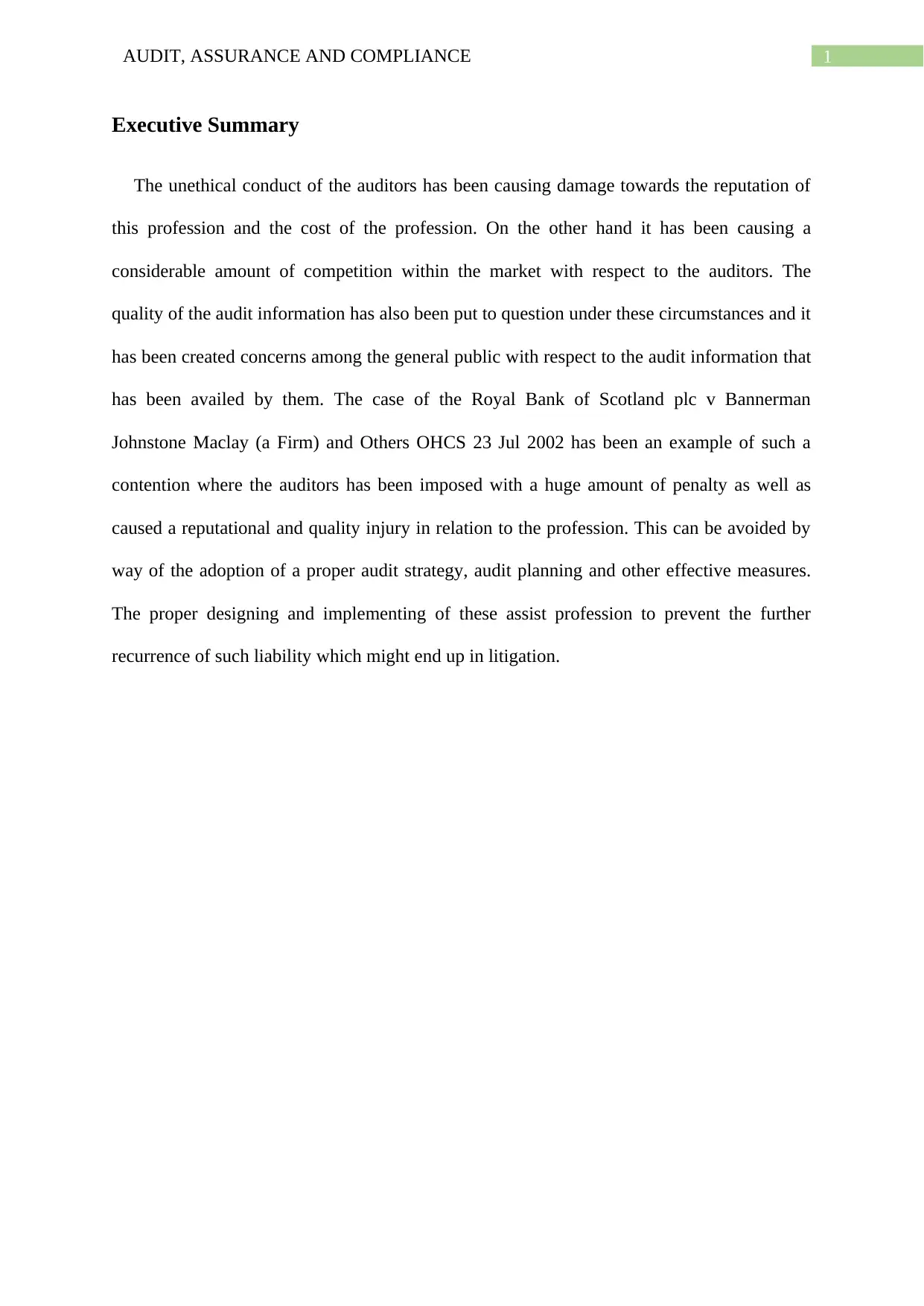
1AUDIT, ASSURANCE AND COMPLIANCE
Executive Summary
The unethical conduct of the auditors has been causing damage towards the reputation of
this profession and the cost of the profession. On the other hand it has been causing a
considerable amount of competition within the market with respect to the auditors. The
quality of the audit information has also been put to question under these circumstances and it
has been created concerns among the general public with respect to the audit information that
has been availed by them. The case of the Royal Bank of Scotland plc v Bannerman
Johnstone Maclay (a Firm) and Others OHCS 23 Jul 2002 has been an example of such a
contention where the auditors has been imposed with a huge amount of penalty as well as
caused a reputational and quality injury in relation to the profession. This can be avoided by
way of the adoption of a proper audit strategy, audit planning and other effective measures.
The proper designing and implementing of these assist profession to prevent the further
recurrence of such liability which might end up in litigation.
Executive Summary
The unethical conduct of the auditors has been causing damage towards the reputation of
this profession and the cost of the profession. On the other hand it has been causing a
considerable amount of competition within the market with respect to the auditors. The
quality of the audit information has also been put to question under these circumstances and it
has been created concerns among the general public with respect to the audit information that
has been availed by them. The case of the Royal Bank of Scotland plc v Bannerman
Johnstone Maclay (a Firm) and Others OHCS 23 Jul 2002 has been an example of such a
contention where the auditors has been imposed with a huge amount of penalty as well as
caused a reputational and quality injury in relation to the profession. This can be avoided by
way of the adoption of a proper audit strategy, audit planning and other effective measures.
The proper designing and implementing of these assist profession to prevent the further
recurrence of such liability which might end up in litigation.
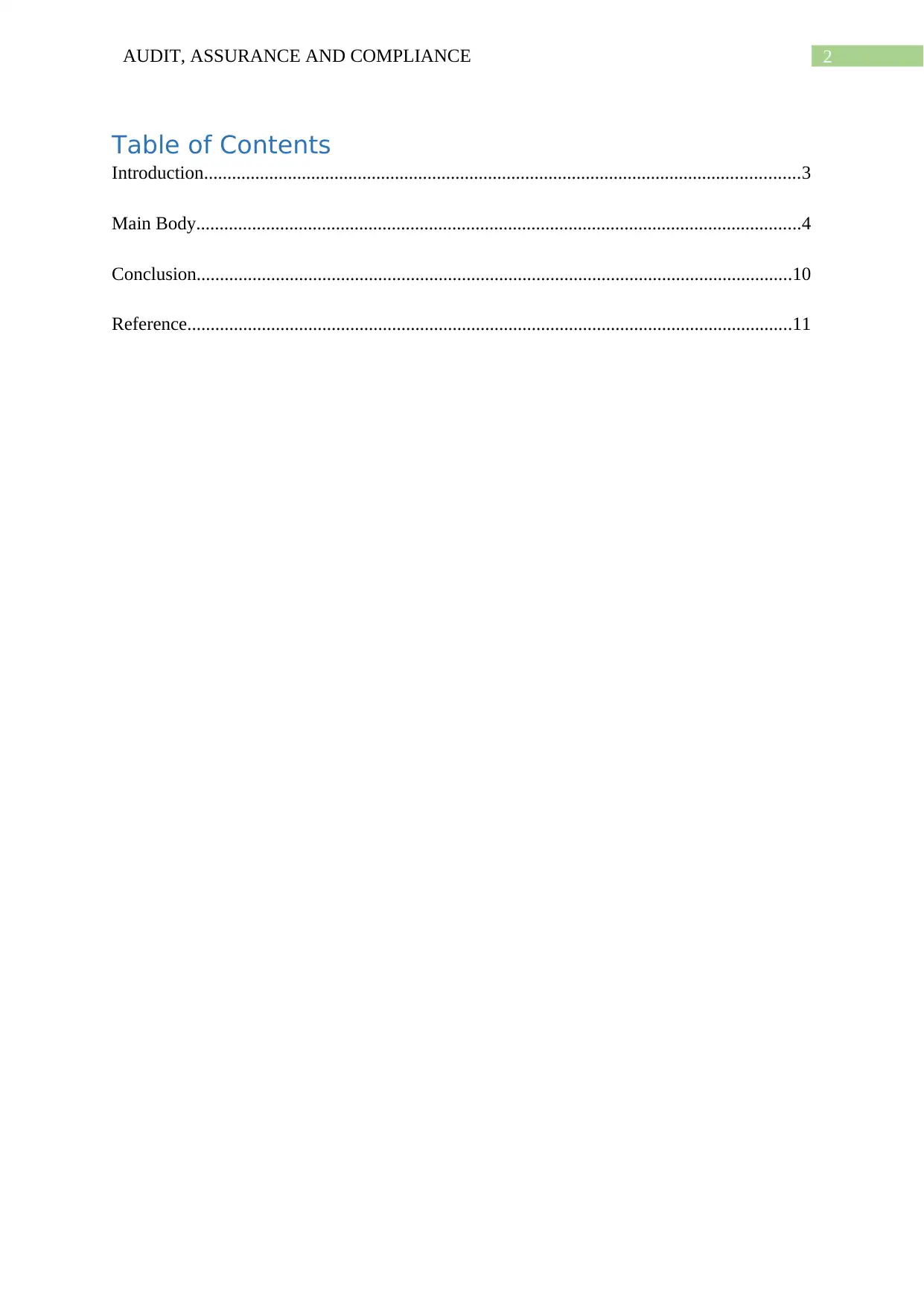
2AUDIT, ASSURANCE AND COMPLIANCE
Table of Contents
Introduction................................................................................................................................3
Main Body..................................................................................................................................4
Conclusion................................................................................................................................10
Reference..................................................................................................................................11
Table of Contents
Introduction................................................................................................................................3
Main Body..................................................................................................................................4
Conclusion................................................................................................................................10
Reference..................................................................................................................................11
⊘ This is a preview!⊘
Do you want full access?
Subscribe today to unlock all pages.

Trusted by 1+ million students worldwide

3AUDIT, ASSURANCE AND COMPLIANCE
Introduction
The auditing profession has been subjected to a considerable amount of reputational as
well as efficiency concerns, which imposes the liability upon the auditors with respect to the
maintenance of the reputation of the profession as well as the assurance with respect to the
quality of the financial services. This does not only imply a damage to the reputation, it also
imposes a hefty amount of costs upon the profession. It also creates a competitive
environment within the audit market (Byrnes et al. 2018). The case of the Royal Bank of
Scotland plc v Bannerman Johnstone Maclay (a Firm) and Others OHCS 23 Jul 2002 has
been an example of such a contention where the auditors has been imposed with a huge
amount of penalty as well as caused a reputational and quality injury in relation to the
profession. In the instant case, the defenders where a chartered accountant firm. They have
been entrusted with the task of the preparation of the accounts of the customer belonging to
the pursuer bank. The bank has brought a claim against the firm, for negligent misstatement
with respect to the accounts of the firm. They also brought a claim for damages against the
firm as they have based their decision to extend a loan towards the customer based on the
accounts provided by the firm. In this furtherance, it has been held by the court that the firm
have been aware of the fact that the accounts that has been provided by them will be chiefly
based upon for the purpose of deciding upon the lending process.
This paper will strive to present a discussion upon the key events and the factual issues
behind the case. It will present an explanation upon the culpability for which parties were
deemed responsible as well as the reasons behind the same and also the damages imposed or
the penalties and consider whether they were appropriate. This paper will also investigate and
explain the relevant issues in Auditing and Accounting raised by the case. It will also strive to
discuss the causation of the issue and will consider market pressure, organisational culture,
Introduction
The auditing profession has been subjected to a considerable amount of reputational as
well as efficiency concerns, which imposes the liability upon the auditors with respect to the
maintenance of the reputation of the profession as well as the assurance with respect to the
quality of the financial services. This does not only imply a damage to the reputation, it also
imposes a hefty amount of costs upon the profession. It also creates a competitive
environment within the audit market (Byrnes et al. 2018). The case of the Royal Bank of
Scotland plc v Bannerman Johnstone Maclay (a Firm) and Others OHCS 23 Jul 2002 has
been an example of such a contention where the auditors has been imposed with a huge
amount of penalty as well as caused a reputational and quality injury in relation to the
profession. In the instant case, the defenders where a chartered accountant firm. They have
been entrusted with the task of the preparation of the accounts of the customer belonging to
the pursuer bank. The bank has brought a claim against the firm, for negligent misstatement
with respect to the accounts of the firm. They also brought a claim for damages against the
firm as they have based their decision to extend a loan towards the customer based on the
accounts provided by the firm. In this furtherance, it has been held by the court that the firm
have been aware of the fact that the accounts that has been provided by them will be chiefly
based upon for the purpose of deciding upon the lending process.
This paper will strive to present a discussion upon the key events and the factual issues
behind the case. It will present an explanation upon the culpability for which parties were
deemed responsible as well as the reasons behind the same and also the damages imposed or
the penalties and consider whether they were appropriate. This paper will also investigate and
explain the relevant issues in Auditing and Accounting raised by the case. It will also strive to
discuss the causation of the issue and will consider market pressure, organisational culture,
Paraphrase This Document
Need a fresh take? Get an instant paraphrase of this document with our AI Paraphraser
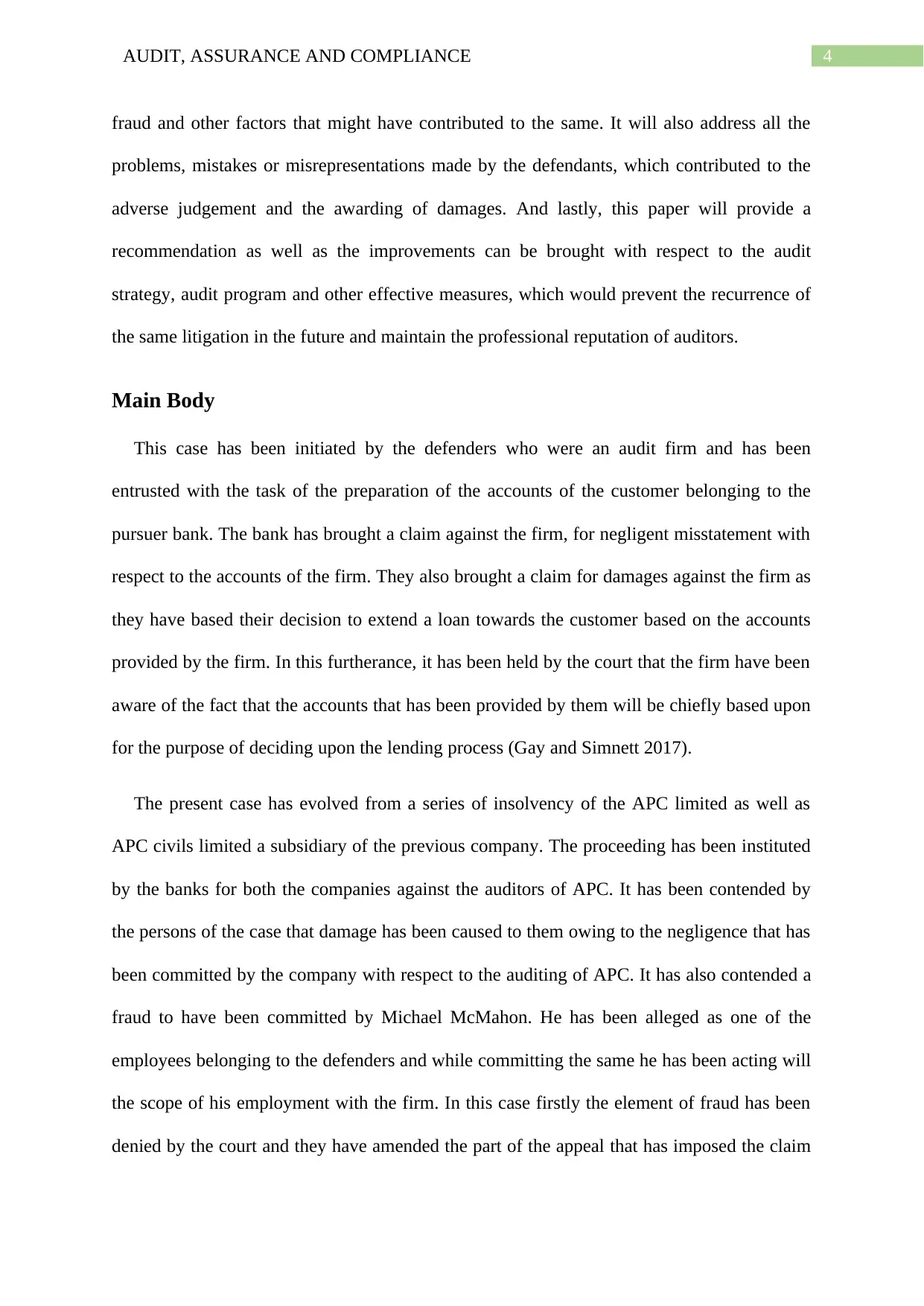
4AUDIT, ASSURANCE AND COMPLIANCE
fraud and other factors that might have contributed to the same. It will also address all the
problems, mistakes or misrepresentations made by the defendants, which contributed to the
adverse judgement and the awarding of damages. And lastly, this paper will provide a
recommendation as well as the improvements can be brought with respect to the audit
strategy, audit program and other effective measures, which would prevent the recurrence of
the same litigation in the future and maintain the professional reputation of auditors.
Main Body
This case has been initiated by the defenders who were an audit firm and has been
entrusted with the task of the preparation of the accounts of the customer belonging to the
pursuer bank. The bank has brought a claim against the firm, for negligent misstatement with
respect to the accounts of the firm. They also brought a claim for damages against the firm as
they have based their decision to extend a loan towards the customer based on the accounts
provided by the firm. In this furtherance, it has been held by the court that the firm have been
aware of the fact that the accounts that has been provided by them will be chiefly based upon
for the purpose of deciding upon the lending process (Gay and Simnett 2017).
The present case has evolved from a series of insolvency of the APC limited as well as
APC civils limited a subsidiary of the previous company. The proceeding has been instituted
by the banks for both the companies against the auditors of APC. It has been contended by
the persons of the case that damage has been caused to them owing to the negligence that has
been committed by the company with respect to the auditing of APC. It has also contended a
fraud to have been committed by Michael McMahon. He has been alleged as one of the
employees belonging to the defenders and while committing the same he has been acting will
the scope of his employment with the firm. In this case firstly the element of fraud has been
denied by the court and they have amended the part of the appeal that has imposed the claim
fraud and other factors that might have contributed to the same. It will also address all the
problems, mistakes or misrepresentations made by the defendants, which contributed to the
adverse judgement and the awarding of damages. And lastly, this paper will provide a
recommendation as well as the improvements can be brought with respect to the audit
strategy, audit program and other effective measures, which would prevent the recurrence of
the same litigation in the future and maintain the professional reputation of auditors.
Main Body
This case has been initiated by the defenders who were an audit firm and has been
entrusted with the task of the preparation of the accounts of the customer belonging to the
pursuer bank. The bank has brought a claim against the firm, for negligent misstatement with
respect to the accounts of the firm. They also brought a claim for damages against the firm as
they have based their decision to extend a loan towards the customer based on the accounts
provided by the firm. In this furtherance, it has been held by the court that the firm have been
aware of the fact that the accounts that has been provided by them will be chiefly based upon
for the purpose of deciding upon the lending process (Gay and Simnett 2017).
The present case has evolved from a series of insolvency of the APC limited as well as
APC civils limited a subsidiary of the previous company. The proceeding has been instituted
by the banks for both the companies against the auditors of APC. It has been contended by
the persons of the case that damage has been caused to them owing to the negligence that has
been committed by the company with respect to the auditing of APC. It has also contended a
fraud to have been committed by Michael McMahon. He has been alleged as one of the
employees belonging to the defenders and while committing the same he has been acting will
the scope of his employment with the firm. In this case firstly the element of fraud has been
denied by the court and they have amended the part of the appeal that has imposed the claim
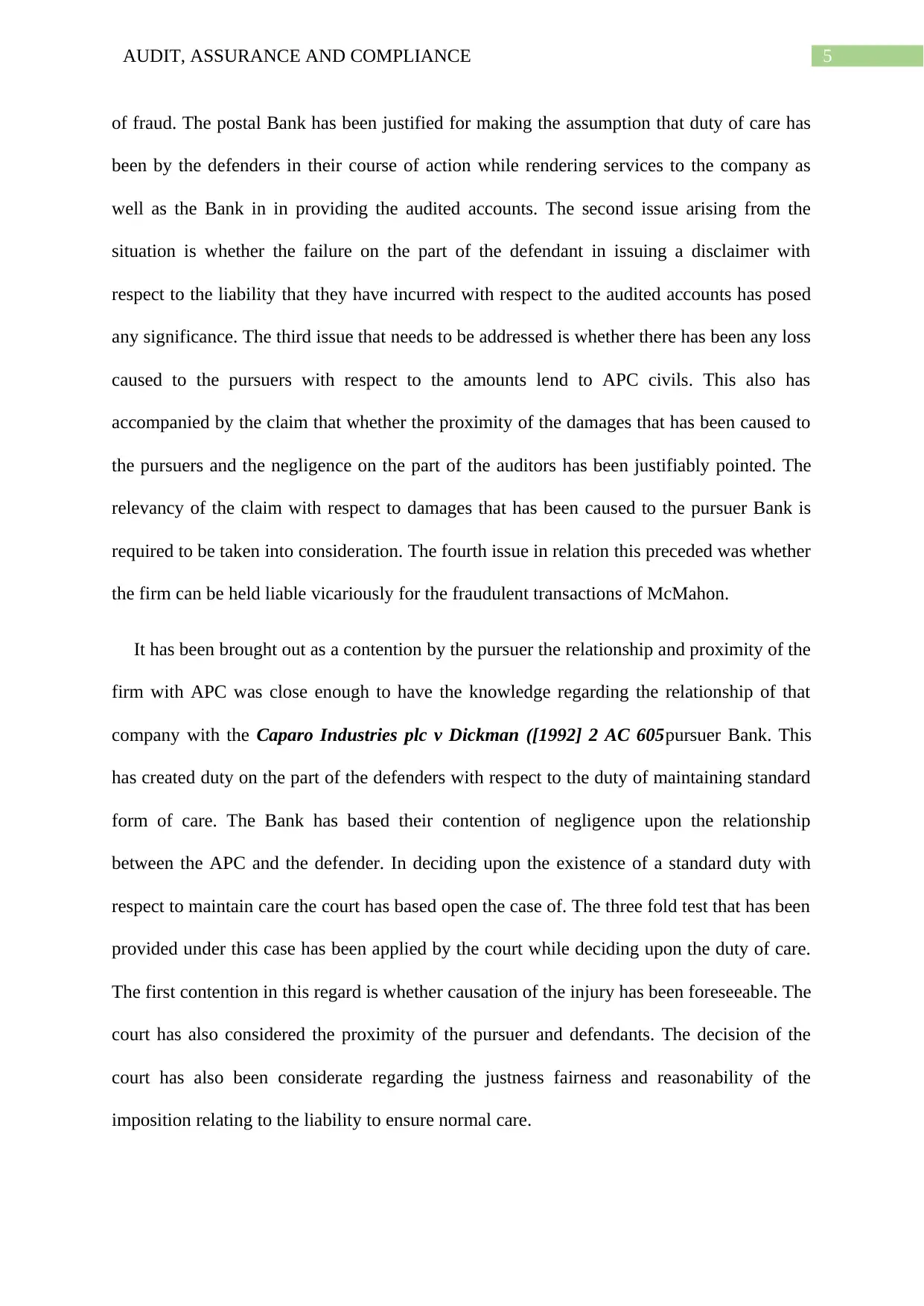
5AUDIT, ASSURANCE AND COMPLIANCE
of fraud. The postal Bank has been justified for making the assumption that duty of care has
been by the defenders in their course of action while rendering services to the company as
well as the Bank in in providing the audited accounts. The second issue arising from the
situation is whether the failure on the part of the defendant in issuing a disclaimer with
respect to the liability that they have incurred with respect to the audited accounts has posed
any significance. The third issue that needs to be addressed is whether there has been any loss
caused to the pursuers with respect to the amounts lend to APC civils. This also has
accompanied by the claim that whether the proximity of the damages that has been caused to
the pursuers and the negligence on the part of the auditors has been justifiably pointed. The
relevancy of the claim with respect to damages that has been caused to the pursuer Bank is
required to be taken into consideration. The fourth issue in relation this preceded was whether
the firm can be held liable vicariously for the fraudulent transactions of McMahon.
It has been brought out as a contention by the pursuer the relationship and proximity of the
firm with APC was close enough to have the knowledge regarding the relationship of that
company with the Caparo Industries plc v Dickman ([1992] 2 AC 605pursuer Bank. This
has created duty on the part of the defenders with respect to the duty of maintaining standard
form of care. The Bank has based their contention of negligence upon the relationship
between the APC and the defender. In deciding upon the existence of a standard duty with
respect to maintain care the court has based open the case of. The three fold test that has been
provided under this case has been applied by the court while deciding upon the duty of care.
The first contention in this regard is whether causation of the injury has been foreseeable. The
court has also considered the proximity of the pursuer and defendants. The decision of the
court has also been considerate regarding the justness fairness and reasonability of the
imposition relating to the liability to ensure normal care.
of fraud. The postal Bank has been justified for making the assumption that duty of care has
been by the defenders in their course of action while rendering services to the company as
well as the Bank in in providing the audited accounts. The second issue arising from the
situation is whether the failure on the part of the defendant in issuing a disclaimer with
respect to the liability that they have incurred with respect to the audited accounts has posed
any significance. The third issue that needs to be addressed is whether there has been any loss
caused to the pursuers with respect to the amounts lend to APC civils. This also has
accompanied by the claim that whether the proximity of the damages that has been caused to
the pursuers and the negligence on the part of the auditors has been justifiably pointed. The
relevancy of the claim with respect to damages that has been caused to the pursuer Bank is
required to be taken into consideration. The fourth issue in relation this preceded was whether
the firm can be held liable vicariously for the fraudulent transactions of McMahon.
It has been brought out as a contention by the pursuer the relationship and proximity of the
firm with APC was close enough to have the knowledge regarding the relationship of that
company with the Caparo Industries plc v Dickman ([1992] 2 AC 605pursuer Bank. This
has created duty on the part of the defenders with respect to the duty of maintaining standard
form of care. The Bank has based their contention of negligence upon the relationship
between the APC and the defender. In deciding upon the existence of a standard duty with
respect to maintain care the court has based open the case of. The three fold test that has been
provided under this case has been applied by the court while deciding upon the duty of care.
The first contention in this regard is whether causation of the injury has been foreseeable. The
court has also considered the proximity of the pursuer and defendants. The decision of the
court has also been considerate regarding the justness fairness and reasonability of the
imposition relating to the liability to ensure normal care.
⊘ This is a preview!⊘
Do you want full access?
Subscribe today to unlock all pages.

Trusted by 1+ million students worldwide
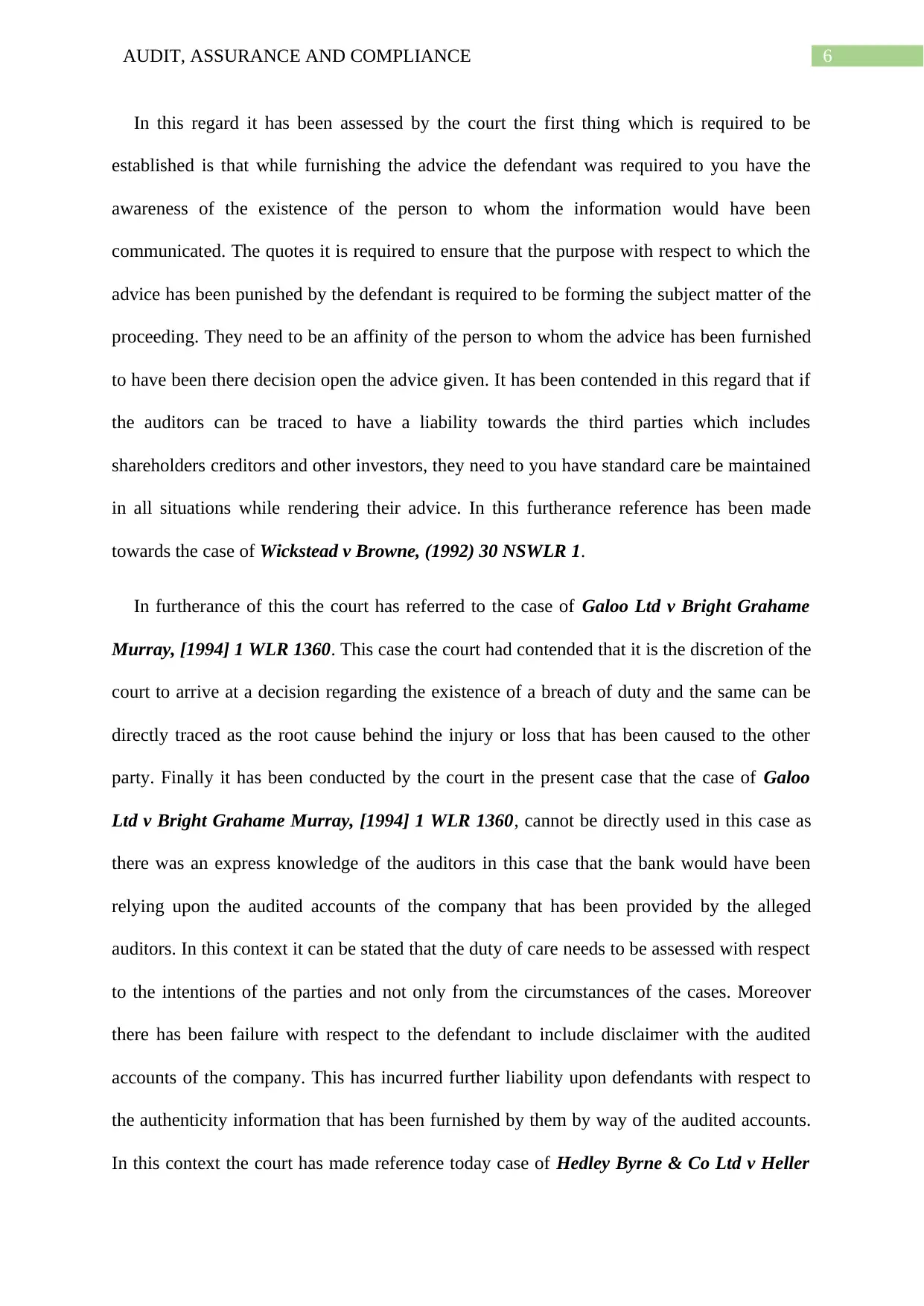
6AUDIT, ASSURANCE AND COMPLIANCE
In this regard it has been assessed by the court the first thing which is required to be
established is that while furnishing the advice the defendant was required to you have the
awareness of the existence of the person to whom the information would have been
communicated. The quotes it is required to ensure that the purpose with respect to which the
advice has been punished by the defendant is required to be forming the subject matter of the
proceeding. They need to be an affinity of the person to whom the advice has been furnished
to have been there decision open the advice given. It has been contended in this regard that if
the auditors can be traced to have a liability towards the third parties which includes
shareholders creditors and other investors, they need to you have standard care be maintained
in all situations while rendering their advice. In this furtherance reference has been made
towards the case of Wickstead v Browne, (1992) 30 NSWLR 1.
In furtherance of this the court has referred to the case of Galoo Ltd v Bright Grahame
Murray, [1994] 1 WLR 1360. This case the court had contended that it is the discretion of the
court to arrive at a decision regarding the existence of a breach of duty and the same can be
directly traced as the root cause behind the injury or loss that has been caused to the other
party. Finally it has been conducted by the court in the present case that the case of Galoo
Ltd v Bright Grahame Murray, [1994] 1 WLR 1360, cannot be directly used in this case as
there was an express knowledge of the auditors in this case that the bank would have been
relying upon the audited accounts of the company that has been provided by the alleged
auditors. In this context it can be stated that the duty of care needs to be assessed with respect
to the intentions of the parties and not only from the circumstances of the cases. Moreover
there has been failure with respect to the defendant to include disclaimer with the audited
accounts of the company. This has incurred further liability upon defendants with respect to
the authenticity information that has been furnished by them by way of the audited accounts.
In this context the court has made reference today case of Hedley Byrne & Co Ltd v Heller
In this regard it has been assessed by the court the first thing which is required to be
established is that while furnishing the advice the defendant was required to you have the
awareness of the existence of the person to whom the information would have been
communicated. The quotes it is required to ensure that the purpose with respect to which the
advice has been punished by the defendant is required to be forming the subject matter of the
proceeding. They need to be an affinity of the person to whom the advice has been furnished
to have been there decision open the advice given. It has been contended in this regard that if
the auditors can be traced to have a liability towards the third parties which includes
shareholders creditors and other investors, they need to you have standard care be maintained
in all situations while rendering their advice. In this furtherance reference has been made
towards the case of Wickstead v Browne, (1992) 30 NSWLR 1.
In furtherance of this the court has referred to the case of Galoo Ltd v Bright Grahame
Murray, [1994] 1 WLR 1360. This case the court had contended that it is the discretion of the
court to arrive at a decision regarding the existence of a breach of duty and the same can be
directly traced as the root cause behind the injury or loss that has been caused to the other
party. Finally it has been conducted by the court in the present case that the case of Galoo
Ltd v Bright Grahame Murray, [1994] 1 WLR 1360, cannot be directly used in this case as
there was an express knowledge of the auditors in this case that the bank would have been
relying upon the audited accounts of the company that has been provided by the alleged
auditors. In this context it can be stated that the duty of care needs to be assessed with respect
to the intentions of the parties and not only from the circumstances of the cases. Moreover
there has been failure with respect to the defendant to include disclaimer with the audited
accounts of the company. This has incurred further liability upon defendants with respect to
the authenticity information that has been furnished by them by way of the audited accounts.
In this context the court has made reference today case of Hedley Byrne & Co Ltd v Heller
Paraphrase This Document
Need a fresh take? Get an instant paraphrase of this document with our AI Paraphraser
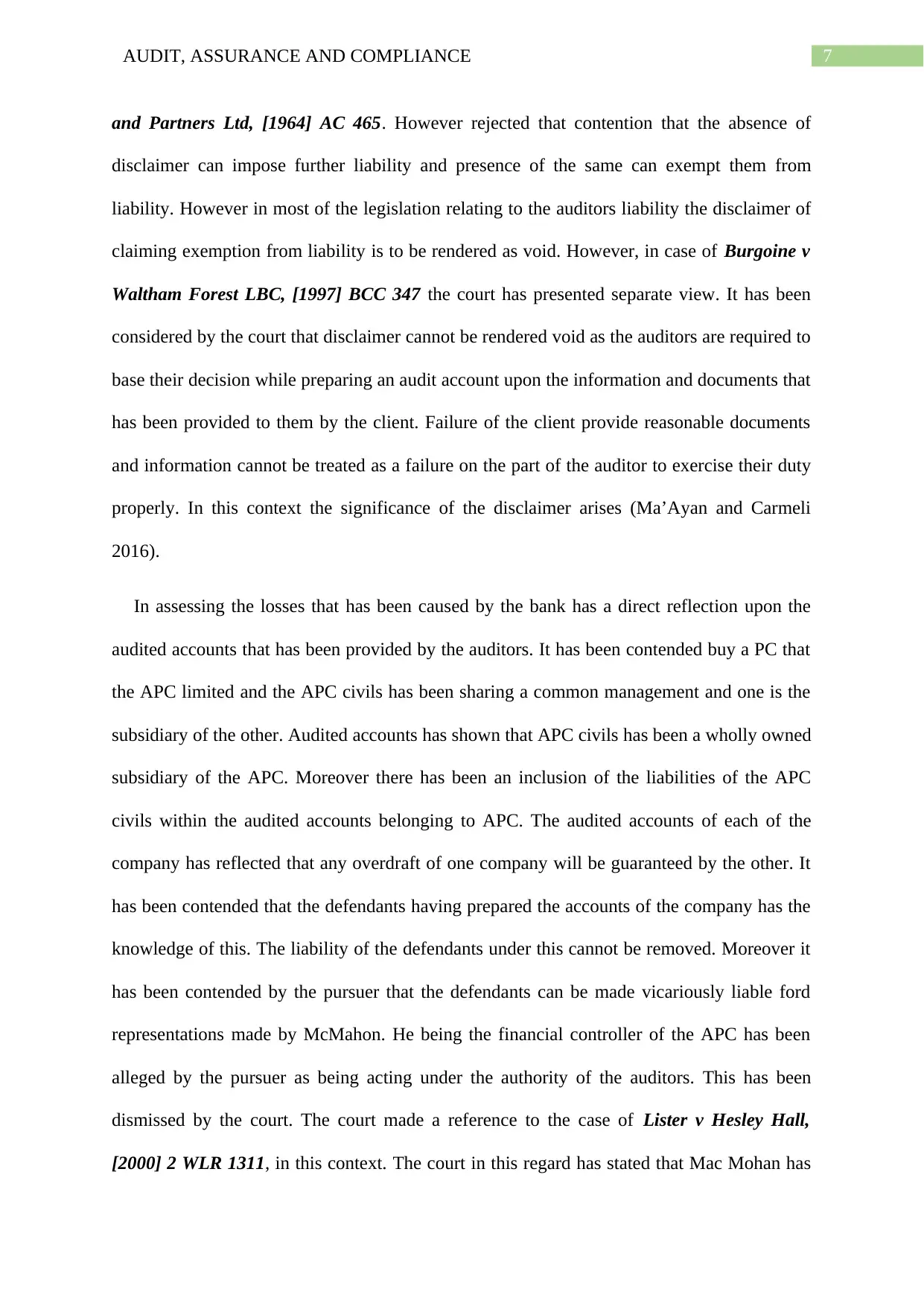
7AUDIT, ASSURANCE AND COMPLIANCE
and Partners Ltd, [1964] AC 465. However rejected that contention that the absence of
disclaimer can impose further liability and presence of the same can exempt them from
liability. However in most of the legislation relating to the auditors liability the disclaimer of
claiming exemption from liability is to be rendered as void. However, in case of Burgoine v
Waltham Forest LBC, [1997] BCC 347 the court has presented separate view. It has been
considered by the court that disclaimer cannot be rendered void as the auditors are required to
base their decision while preparing an audit account upon the information and documents that
has been provided to them by the client. Failure of the client provide reasonable documents
and information cannot be treated as a failure on the part of the auditor to exercise their duty
properly. In this context the significance of the disclaimer arises (Ma’Ayan and Carmeli
2016).
In assessing the losses that has been caused by the bank has a direct reflection upon the
audited accounts that has been provided by the auditors. It has been contended buy a PC that
the APC limited and the APC civils has been sharing a common management and one is the
subsidiary of the other. Audited accounts has shown that APC civils has been a wholly owned
subsidiary of the APC. Moreover there has been an inclusion of the liabilities of the APC
civils within the audited accounts belonging to APC. The audited accounts of each of the
company has reflected that any overdraft of one company will be guaranteed by the other. It
has been contended that the defendants having prepared the accounts of the company has the
knowledge of this. The liability of the defendants under this cannot be removed. Moreover it
has been contended by the pursuer that the defendants can be made vicariously liable ford
representations made by McMahon. He being the financial controller of the APC has been
alleged by the pursuer as being acting under the authority of the auditors. This has been
dismissed by the court. The court made a reference to the case of Lister v Hesley Hall,
[2000] 2 WLR 1311, in this context. The court in this regard has stated that Mac Mohan has
and Partners Ltd, [1964] AC 465. However rejected that contention that the absence of
disclaimer can impose further liability and presence of the same can exempt them from
liability. However in most of the legislation relating to the auditors liability the disclaimer of
claiming exemption from liability is to be rendered as void. However, in case of Burgoine v
Waltham Forest LBC, [1997] BCC 347 the court has presented separate view. It has been
considered by the court that disclaimer cannot be rendered void as the auditors are required to
base their decision while preparing an audit account upon the information and documents that
has been provided to them by the client. Failure of the client provide reasonable documents
and information cannot be treated as a failure on the part of the auditor to exercise their duty
properly. In this context the significance of the disclaimer arises (Ma’Ayan and Carmeli
2016).
In assessing the losses that has been caused by the bank has a direct reflection upon the
audited accounts that has been provided by the auditors. It has been contended buy a PC that
the APC limited and the APC civils has been sharing a common management and one is the
subsidiary of the other. Audited accounts has shown that APC civils has been a wholly owned
subsidiary of the APC. Moreover there has been an inclusion of the liabilities of the APC
civils within the audited accounts belonging to APC. The audited accounts of each of the
company has reflected that any overdraft of one company will be guaranteed by the other. It
has been contended that the defendants having prepared the accounts of the company has the
knowledge of this. The liability of the defendants under this cannot be removed. Moreover it
has been contended by the pursuer that the defendants can be made vicariously liable ford
representations made by McMahon. He being the financial controller of the APC has been
alleged by the pursuer as being acting under the authority of the auditors. This has been
dismissed by the court. The court made a reference to the case of Lister v Hesley Hall,
[2000] 2 WLR 1311, in this context. The court in this regard has stated that Mac Mohan has

8AUDIT, ASSURANCE AND COMPLIANCE
been employed with the APC and not with the auditors. He has been acting under the
authority provided towards him by the company and has no duty towards the auditors. Hence
any fraud that will be committed by him will not hold the auditors liable. This is because his
fraudulent acts has been in the furtherance of his employment with the company and not with
the auditors. Hence, the auditors cannot be treated as vicariously liable as that would amount
to an unjust decision.
This case has attracted a considerable amount of media coverage. It has caused the audit
firm to have incurred hefty amount of expenditure in contesting the litigation. This preceding
has manifold implications within the professional scenario pertaining to the auditors. On one
hand it has been causing damage towards the reputation of this profession and the cost of the
profession. On the other hand it has been causing a considerable amount of competition
within the market with respect to the auditors. The quality of the audit information has also
been put to question under these circumstances and it has been created concerns among the
general public with respect to the audit information that has been availed by them. Under
these circumstances the auditors or under an obligation to refrain from indulging into
activities, which are unethical for the purpose of their profession. This can be ensured by way
of the adoption of a proper audit strategy, audit planning and other effective measures. The
proper designing and implementing of these assist profession to prevent the further
recurrence of such liability which might end up in litigation. It would also restore the
reputation belonging to the auditors enhance the reliance of the auditors by the general public
(Knechel and Salterio 2016).
While employing a particular audit strategy the auditor needs to identify all the features
relating to the engagement for the purpose of defining the scope of the particular audit in
question. In doing the same it needs to identify the audit coverage that are expected. This may
include the locations and the number of components that are required to be included within
been employed with the APC and not with the auditors. He has been acting under the
authority provided towards him by the company and has no duty towards the auditors. Hence
any fraud that will be committed by him will not hold the auditors liable. This is because his
fraudulent acts has been in the furtherance of his employment with the company and not with
the auditors. Hence, the auditors cannot be treated as vicariously liable as that would amount
to an unjust decision.
This case has attracted a considerable amount of media coverage. It has caused the audit
firm to have incurred hefty amount of expenditure in contesting the litigation. This preceding
has manifold implications within the professional scenario pertaining to the auditors. On one
hand it has been causing damage towards the reputation of this profession and the cost of the
profession. On the other hand it has been causing a considerable amount of competition
within the market with respect to the auditors. The quality of the audit information has also
been put to question under these circumstances and it has been created concerns among the
general public with respect to the audit information that has been availed by them. Under
these circumstances the auditors or under an obligation to refrain from indulging into
activities, which are unethical for the purpose of their profession. This can be ensured by way
of the adoption of a proper audit strategy, audit planning and other effective measures. The
proper designing and implementing of these assist profession to prevent the further
recurrence of such liability which might end up in litigation. It would also restore the
reputation belonging to the auditors enhance the reliance of the auditors by the general public
(Knechel and Salterio 2016).
While employing a particular audit strategy the auditor needs to identify all the features
relating to the engagement for the purpose of defining the scope of the particular audit in
question. In doing the same it needs to identify the audit coverage that are expected. This may
include the locations and the number of components that are required to be included within
⊘ This is a preview!⊘
Do you want full access?
Subscribe today to unlock all pages.

Trusted by 1+ million students worldwide
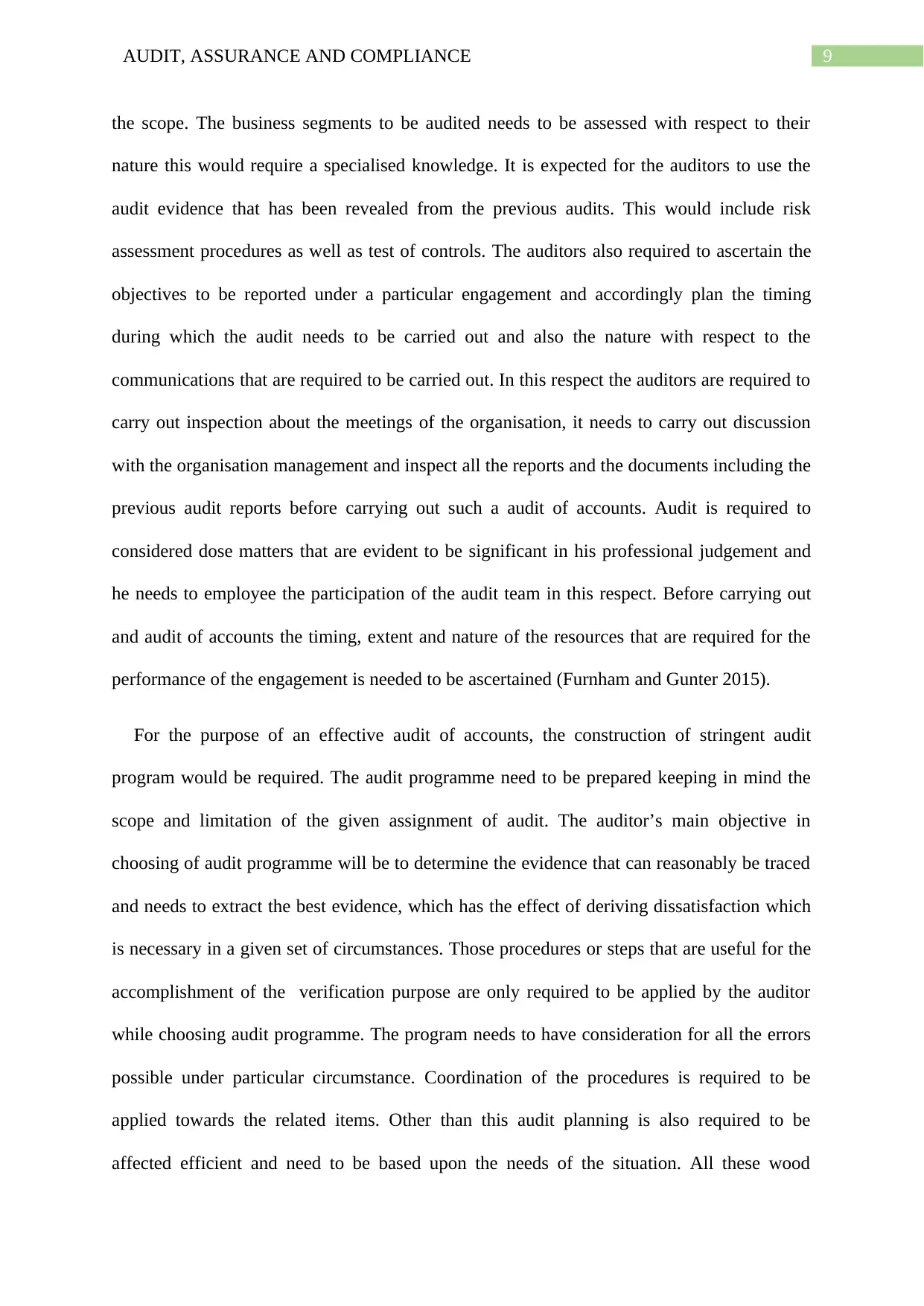
9AUDIT, ASSURANCE AND COMPLIANCE
the scope. The business segments to be audited needs to be assessed with respect to their
nature this would require a specialised knowledge. It is expected for the auditors to use the
audit evidence that has been revealed from the previous audits. This would include risk
assessment procedures as well as test of controls. The auditors also required to ascertain the
objectives to be reported under a particular engagement and accordingly plan the timing
during which the audit needs to be carried out and also the nature with respect to the
communications that are required to be carried out. In this respect the auditors are required to
carry out inspection about the meetings of the organisation, it needs to carry out discussion
with the organisation management and inspect all the reports and the documents including the
previous audit reports before carrying out such a audit of accounts. Audit is required to
considered dose matters that are evident to be significant in his professional judgement and
he needs to employee the participation of the audit team in this respect. Before carrying out
and audit of accounts the timing, extent and nature of the resources that are required for the
performance of the engagement is needed to be ascertained (Furnham and Gunter 2015).
For the purpose of an effective audit of accounts, the construction of stringent audit
program would be required. The audit programme need to be prepared keeping in mind the
scope and limitation of the given assignment of audit. The auditor’s main objective in
choosing of audit programme will be to determine the evidence that can reasonably be traced
and needs to extract the best evidence, which has the effect of deriving dissatisfaction which
is necessary in a given set of circumstances. Those procedures or steps that are useful for the
accomplishment of the verification purpose are only required to be applied by the auditor
while choosing audit programme. The program needs to have consideration for all the errors
possible under particular circumstance. Coordination of the procedures is required to be
applied towards the related items. Other than this audit planning is also required to be
affected efficient and need to be based upon the needs of the situation. All these wood
the scope. The business segments to be audited needs to be assessed with respect to their
nature this would require a specialised knowledge. It is expected for the auditors to use the
audit evidence that has been revealed from the previous audits. This would include risk
assessment procedures as well as test of controls. The auditors also required to ascertain the
objectives to be reported under a particular engagement and accordingly plan the timing
during which the audit needs to be carried out and also the nature with respect to the
communications that are required to be carried out. In this respect the auditors are required to
carry out inspection about the meetings of the organisation, it needs to carry out discussion
with the organisation management and inspect all the reports and the documents including the
previous audit reports before carrying out such a audit of accounts. Audit is required to
considered dose matters that are evident to be significant in his professional judgement and
he needs to employee the participation of the audit team in this respect. Before carrying out
and audit of accounts the timing, extent and nature of the resources that are required for the
performance of the engagement is needed to be ascertained (Furnham and Gunter 2015).
For the purpose of an effective audit of accounts, the construction of stringent audit
program would be required. The audit programme need to be prepared keeping in mind the
scope and limitation of the given assignment of audit. The auditor’s main objective in
choosing of audit programme will be to determine the evidence that can reasonably be traced
and needs to extract the best evidence, which has the effect of deriving dissatisfaction which
is necessary in a given set of circumstances. Those procedures or steps that are useful for the
accomplishment of the verification purpose are only required to be applied by the auditor
while choosing audit programme. The program needs to have consideration for all the errors
possible under particular circumstance. Coordination of the procedures is required to be
applied towards the related items. Other than this audit planning is also required to be
affected efficient and need to be based upon the needs of the situation. All these wood
Paraphrase This Document
Need a fresh take? Get an instant paraphrase of this document with our AI Paraphraser
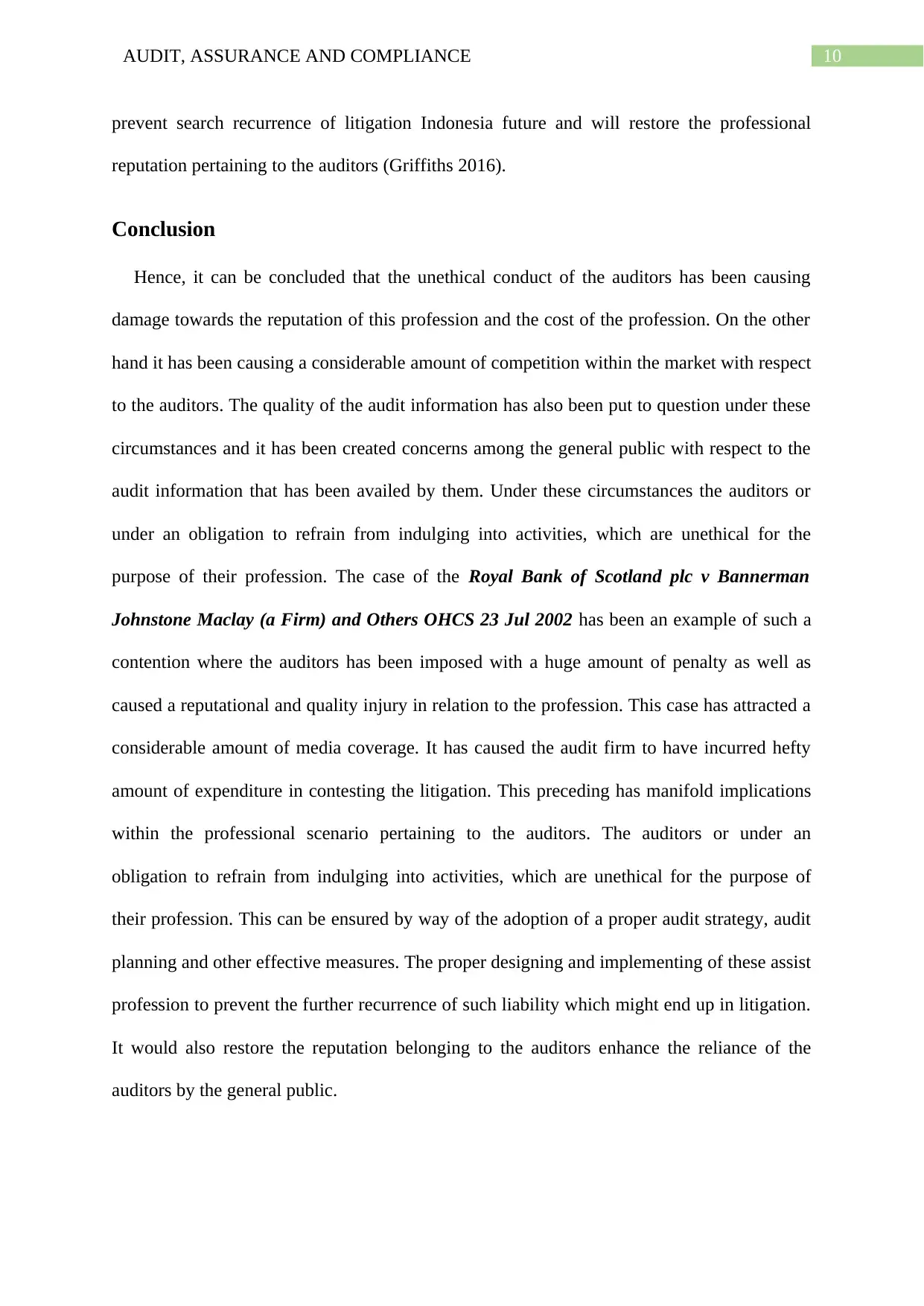
10AUDIT, ASSURANCE AND COMPLIANCE
prevent search recurrence of litigation Indonesia future and will restore the professional
reputation pertaining to the auditors (Griffiths 2016).
Conclusion
Hence, it can be concluded that the unethical conduct of the auditors has been causing
damage towards the reputation of this profession and the cost of the profession. On the other
hand it has been causing a considerable amount of competition within the market with respect
to the auditors. The quality of the audit information has also been put to question under these
circumstances and it has been created concerns among the general public with respect to the
audit information that has been availed by them. Under these circumstances the auditors or
under an obligation to refrain from indulging into activities, which are unethical for the
purpose of their profession. The case of the Royal Bank of Scotland plc v Bannerman
Johnstone Maclay (a Firm) and Others OHCS 23 Jul 2002 has been an example of such a
contention where the auditors has been imposed with a huge amount of penalty as well as
caused a reputational and quality injury in relation to the profession. This case has attracted a
considerable amount of media coverage. It has caused the audit firm to have incurred hefty
amount of expenditure in contesting the litigation. This preceding has manifold implications
within the professional scenario pertaining to the auditors. The auditors or under an
obligation to refrain from indulging into activities, which are unethical for the purpose of
their profession. This can be ensured by way of the adoption of a proper audit strategy, audit
planning and other effective measures. The proper designing and implementing of these assist
profession to prevent the further recurrence of such liability which might end up in litigation.
It would also restore the reputation belonging to the auditors enhance the reliance of the
auditors by the general public.
prevent search recurrence of litigation Indonesia future and will restore the professional
reputation pertaining to the auditors (Griffiths 2016).
Conclusion
Hence, it can be concluded that the unethical conduct of the auditors has been causing
damage towards the reputation of this profession and the cost of the profession. On the other
hand it has been causing a considerable amount of competition within the market with respect
to the auditors. The quality of the audit information has also been put to question under these
circumstances and it has been created concerns among the general public with respect to the
audit information that has been availed by them. Under these circumstances the auditors or
under an obligation to refrain from indulging into activities, which are unethical for the
purpose of their profession. The case of the Royal Bank of Scotland plc v Bannerman
Johnstone Maclay (a Firm) and Others OHCS 23 Jul 2002 has been an example of such a
contention where the auditors has been imposed with a huge amount of penalty as well as
caused a reputational and quality injury in relation to the profession. This case has attracted a
considerable amount of media coverage. It has caused the audit firm to have incurred hefty
amount of expenditure in contesting the litigation. This preceding has manifold implications
within the professional scenario pertaining to the auditors. The auditors or under an
obligation to refrain from indulging into activities, which are unethical for the purpose of
their profession. This can be ensured by way of the adoption of a proper audit strategy, audit
planning and other effective measures. The proper designing and implementing of these assist
profession to prevent the further recurrence of such liability which might end up in litigation.
It would also restore the reputation belonging to the auditors enhance the reliance of the
auditors by the general public.
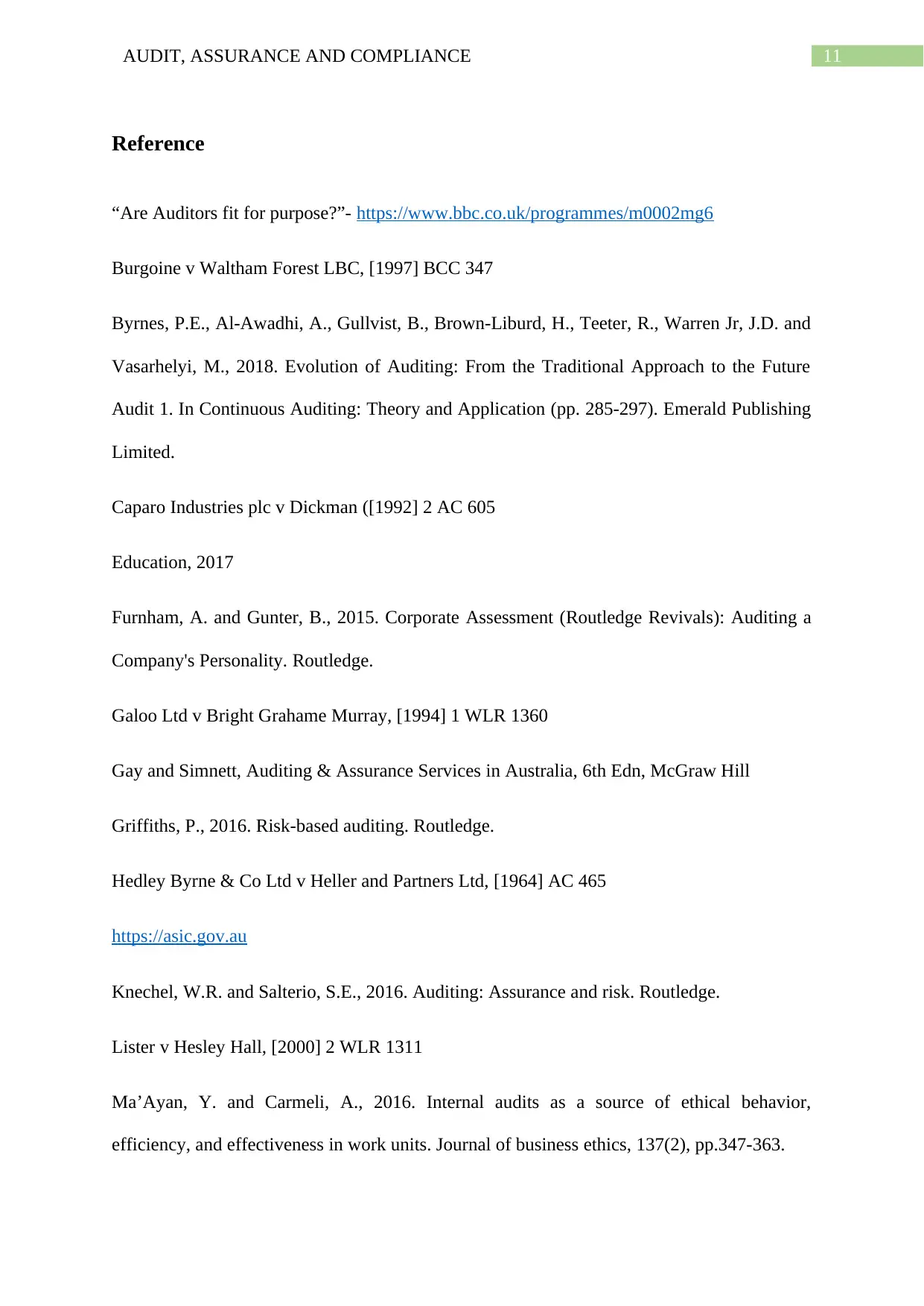
11AUDIT, ASSURANCE AND COMPLIANCE
Reference
“Are Auditors fit for purpose?”- https://www.bbc.co.uk/programmes/m0002mg6
Burgoine v Waltham Forest LBC, [1997] BCC 347
Byrnes, P.E., Al-Awadhi, A., Gullvist, B., Brown-Liburd, H., Teeter, R., Warren Jr, J.D. and
Vasarhelyi, M., 2018. Evolution of Auditing: From the Traditional Approach to the Future
Audit 1. In Continuous Auditing: Theory and Application (pp. 285-297). Emerald Publishing
Limited.
Caparo Industries plc v Dickman ([1992] 2 AC 605
Education, 2017
Furnham, A. and Gunter, B., 2015. Corporate Assessment (Routledge Revivals): Auditing a
Company's Personality. Routledge.
Galoo Ltd v Bright Grahame Murray, [1994] 1 WLR 1360
Gay and Simnett, Auditing & Assurance Services in Australia, 6th Edn, McGraw Hill
Griffiths, P., 2016. Risk-based auditing. Routledge.
Hedley Byrne & Co Ltd v Heller and Partners Ltd, [1964] AC 465
https://asic.gov.au
Knechel, W.R. and Salterio, S.E., 2016. Auditing: Assurance and risk. Routledge.
Lister v Hesley Hall, [2000] 2 WLR 1311
Ma’Ayan, Y. and Carmeli, A., 2016. Internal audits as a source of ethical behavior,
efficiency, and effectiveness in work units. Journal of business ethics, 137(2), pp.347-363.
Reference
“Are Auditors fit for purpose?”- https://www.bbc.co.uk/programmes/m0002mg6
Burgoine v Waltham Forest LBC, [1997] BCC 347
Byrnes, P.E., Al-Awadhi, A., Gullvist, B., Brown-Liburd, H., Teeter, R., Warren Jr, J.D. and
Vasarhelyi, M., 2018. Evolution of Auditing: From the Traditional Approach to the Future
Audit 1. In Continuous Auditing: Theory and Application (pp. 285-297). Emerald Publishing
Limited.
Caparo Industries plc v Dickman ([1992] 2 AC 605
Education, 2017
Furnham, A. and Gunter, B., 2015. Corporate Assessment (Routledge Revivals): Auditing a
Company's Personality. Routledge.
Galoo Ltd v Bright Grahame Murray, [1994] 1 WLR 1360
Gay and Simnett, Auditing & Assurance Services in Australia, 6th Edn, McGraw Hill
Griffiths, P., 2016. Risk-based auditing. Routledge.
Hedley Byrne & Co Ltd v Heller and Partners Ltd, [1964] AC 465
https://asic.gov.au
Knechel, W.R. and Salterio, S.E., 2016. Auditing: Assurance and risk. Routledge.
Lister v Hesley Hall, [2000] 2 WLR 1311
Ma’Ayan, Y. and Carmeli, A., 2016. Internal audits as a source of ethical behavior,
efficiency, and effectiveness in work units. Journal of business ethics, 137(2), pp.347-363.
⊘ This is a preview!⊘
Do you want full access?
Subscribe today to unlock all pages.

Trusted by 1+ million students worldwide
1 out of 13
Related Documents
Your All-in-One AI-Powered Toolkit for Academic Success.
+13062052269
info@desklib.com
Available 24*7 on WhatsApp / Email
![[object Object]](/_next/static/media/star-bottom.7253800d.svg)
Unlock your academic potential
Copyright © 2020–2025 A2Z Services. All Rights Reserved. Developed and managed by ZUCOL.




